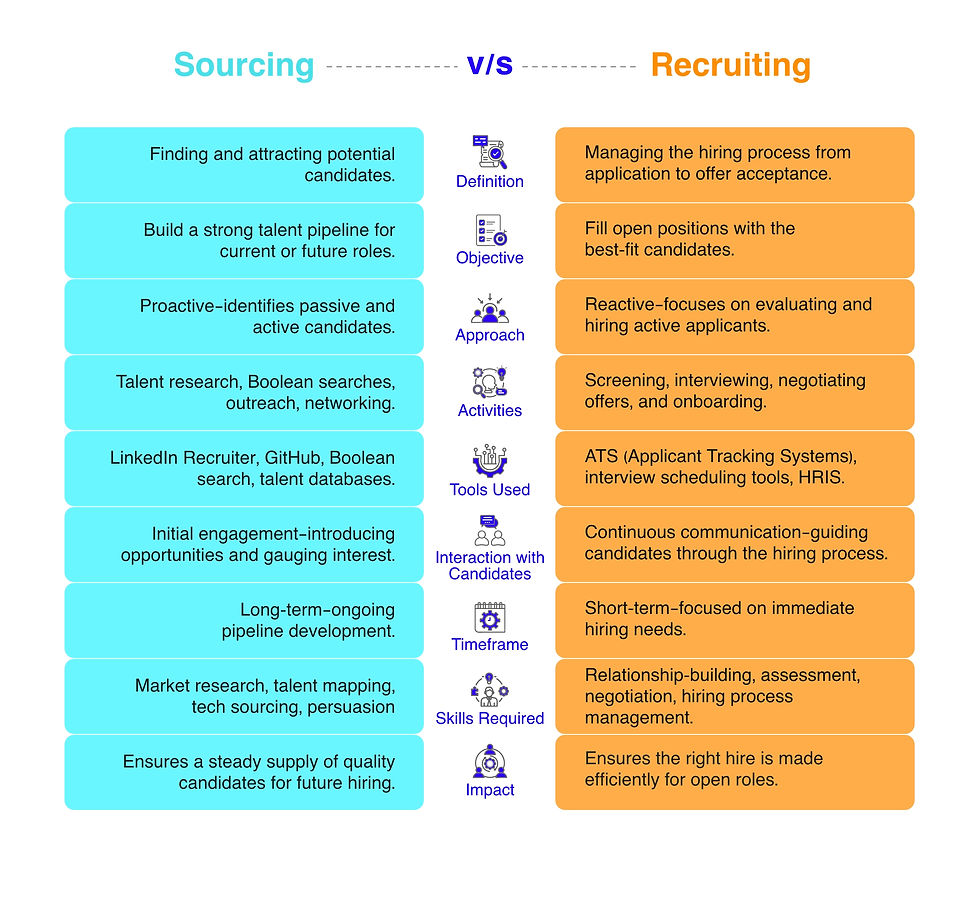Sourcing vs. Recruiting: Key Differences and Insights Explained
- Quentin Sebastian
- Feb 7
- 6 min read

You ever see a quarterback and a wide receiver confused for the same position? Nope.
Because one throws the ball, and the other catches it.
Yet, in the world of hiring, people mix up sourcing and recruiting all the time.They’re both critical, they work together, but they do very different jobs.
So, let’s break it down—quick, sharp, and with zero corporate jargon.

What is the difference between sourcing and
recruiting?
Think of it like dating.
Sourcing is finding people you might want to go out with. It is more like swiping algorithmically matched profiles left and right on a dating app. Screening before you meet.
Recruiting is actually going on the date and seeing if there’s a match.
Sourcing hunts.
Recruiting hires.
One finds, the other closes.
Now, let’s put them head-to-head in every key aspect.
Definition
Sourcing is the art of finding and attracting top talent.
Recruiting is the science of managing the hiring process from application to offer.
Sourcing is the talent detective work—digging through LinkedIn, Boolean searches, and referrals to locate the best potential hires.
Recruiting takes those potential hires and guides them through the hiring maze.
A good recruiter might never have to source—if there’s already a steady pipeline.
A good sourcer never stops finding new talent—because hiring needs never stop.
Objective
Sourcing builds a rock-solid talent pipeline.
Recruiting fills open positions as soon as possible.
Sourcing is the long game, always scouting for future roles.
Recruiting is the now game, filling roles before the hiring manager starts sending passive-aggressive emails.
A company with strong sourcing efforts rarely scrambles when hiring needs spike.
A company that neglects sourcing constantly plays catch-up.
Approach
Sourcing is proactive—identifies passive and active candidates.
Recruiting is reactive—focuses on evaluating and hiring active applicants.
Sourcing means reaching out to people who aren’t even looking.
Recruiting is working with candidates who already applied.
Sourcing asks, “Who might be a great fit down the line?”Recruiting asks, “Who can fill this role right now?”
One is headhunting.
The other is matchmaking.
Key Activities
Sourcing:
Talent research
Boolean search wizardry
Talent mapping
Outreach and networking
Passive candidate engagement
Competitive intelligence gathering
Employer branding support
Recruiting:
Screening applications
Conducting interviews
Negotiating offers
Managing the onboarding process
Coordinating with hiring managers
Ensuring compliance and fair hiring practices
Sourcing is the "Hi, we’d love to chat."
Recruiting is the "Congrats, here’s your offer."
Tools Used
Sourcing:
LinkedIn Recruiter
GitHub (for tech sourcing)
Boolean search strings
Talent databases and sourcing extensions
Twitter, Slack communities, and niche job boards
Recruiting:
ATS (Applicant Tracking System)
Interview scheduling tools
HRIS (Human Resources Information System)
Background check software
Job posting platforms (Indeed, Glassdoor, etc.)
Sourcing tools find people.
Recruiting tools hire people.
Interaction with Candidates
Sourcing is the first conversation, the first introduction.
Recruiting is the relationship-building that follows.
Sourcing warms up candidates.
Recruiting closes the deal.
A strong sourcing function makes recruiting easier.
A weak sourcing function makes recruiting harder.
Timeframe
Sourcing is long-term, always filling the talent pipeline.
Recruiting is short-term, focused on the current hiring need.
Sourcing is like planting seeds.
Recruiting is harvesting the crops.
Companies that prioritize sourcing don’t scramble for talent when they need it.
Companies that only focus on recruiting often panic when roles go unfilled.
Skills Required
-Sourcing:
Market research: Involves analyzing industry trends, competitor talent pools, and emerging skill sets to identify potential hiring opportunities. It informs targeted recruitment strategies for organizational growth.
Talent mapping: A strategic process of identifying and categorizing talent across specific sectors. It helps anticipate future hiring needs and build a pipeline for critical roles.
Tech sourcing: Focuses on identifying and engaging with skilled tech professionals. This requires in-depth understanding of programming languages, software, and trends in tech innovation.
Persuasion and outreach: Involves proactive communication with candidates, often requiring tailored messaging to highlight the benefits of a role or organization. It's crucial for engaging passive candidates.
Boolean search mastery: A technique used to conduct highly specific and effective candidate searches on databases and job boards. Mastering Boolean strings increases sourcing efficiency and precision.
Data-driven decision-making: Relies on analytics to make informed decisions throughout the hiring process. It ensures that choices are based on metrics like candidate performance and hiring outcomes.
-Recruiting:
Relationship-building: Establishing and nurturing long-term connections with candidates and hiring managers. This fosters trust, enhancing future recruitment efforts and candidate engagement.
Candidate assessment: Involves evaluating candidates' qualifications, cultural fit, and potential for growth. This is essential for ensuring long-term success in the role.
Negotiation: The art of aligning candidates' expectations with organizational needs. Effective negotiation ensures mutual satisfaction and retention, balancing salary, benefits, and role responsibilities.
Hiring process management: Ensures smooth coordination of every stage from job posting to offer letter. Streamlining this process enhances candidate experience and reduces time-to-hire.
Compliance and legal knowledge: Involves understanding labor laws, discrimination policies, and employment contracts. Compliance is vital to mitigate risks and ensure ethical hiring practices.
Strong interviewing techniques: Focuses on asking insightful, structured questions to assess a candidate's qualifications and soft skills. Strong interviewing helps predict candidate success and organizational fit.
Sourcing is about detective skills.
Recruiting is about people skills.
Common challenges and how to overcome them
-Sourcing Challenges:
Finding qualified candidates in niche markets.
Getting responses from passive candidates.
Navigating outdated or incomplete candidate data.
Solutions:
Use industry-specific job boards and networking groups.
Personalize outreach messages to increase response rates.
Regularly update and clean candidate databases.
Leverage AI-powered sourcing tools to automate tedious tasks.
-Recruiting Challenges:
Managing high applicant volume efficiently.
Ensuring a smooth candidate experience.
Competing against multiple job offers.
Managing internal hiring expectations.
Solutions:
Implement AI-driven ATS for better applicant filtering.
Communicate clearly and frequently with candidates.
Highlight company culture and benefits early in the process.
Train hiring managers on fast, effective decision-making.
Real-World Sourcing and Recruiting

Sourcing in Action:
An Australian tech company faced rapid growth and a significant challenge in recruiting the talent required to keep up with their increasing business demand. With a shortage of skilled professionals in Australia’s tech sector, they struggled to engage and onboard the right candidates in time.
To overcome this, Fabric Group partnered with Rent-A-Sourcer, outsourcing their recruitment efforts. Our team, led by Co-Founder Quentin Sebastian, applied our SOQS methodology—Sourcing, Outreach, Qualifying, and Scheduling. We targeted top-tier talent from companies like MYOB, XERO, and Telstra, mapping and engaging high-quality candidates to build a sustainable talent pipeline.
Within seven months, Rent-A-Sourcer delivered impressive results, providing Fabric Group with a steady flow of pre-validated candidates. According to Simon Greed, COO of Fabric Group, the collaboration has been a resounding success, with many candidates transitioning into permanent roles. This partnership demonstrated our ability to scale recruitment in alignment with business growth.
Recruiting in Action:
At Google, innovation has always been the cornerstone of success. As one of the tech world's giants, the company understood that attracting the best talent was essential to maintaining that edge. However, like many others, Google found itself navigating the challenges posed by economic downturns, which made meeting hiring targets more difficult.
To tackle this, Google adjusted its recruiting strategy. In addition to enhancing diversity, it introduced mentorship programs and networking opportunities aimed at helping underrepresented groups, including women, break into tech. These efforts went beyond the workplace, extending to events like conferences and hackathons.
To further bolster recruitment, Google launched specialized training programs that helped individuals—from novices to job-ready candidates—gain the necessary skills. This not only ensured smooth onboarding but also provided a continuous source of talent. With these initiatives, Google successfully adapted to challenging economic conditions, all while fostering a diverse and skilled workforce.
Impact
Sourcing ensures a steady supply of candidates for future roles.
Recruiting ensures the best hire is made efficiently.
Sourcing prevents hiring droughts.
Recruiting prevents hiring disasters.
When both functions work in harmony, hiring becomes strategic rather than reactive.
Best Practices for Maximizing Efficiency
Align sourcing and recruiting teams for seamless transitions.
Leverage data analytics to refine search criteria and hiring strategies.
Build and nurture candidate relationships before roles even open.
Create an engaging employer brand to attract top talent effortlessly.
Train recruiters to source and sourcers to understand recruiting workflows.
Regularly assess and update sourcing and recruiting strategies.
The Bottom Line
They’re different, but they need each other.
No sourcing? No talent pipeline.
No recruiting? No hires.
One finds.
One hires.
Sourcing vs. Recruiting in One Line
Sourcing feeds the pipeline, recruiting closes the hire. Both work hand-in-hand, but sourcing is about finding talent, while recruiting is about securing it.




